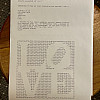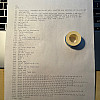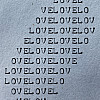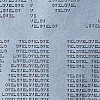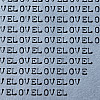LOVE
An essay on the BASIC program LOVE
November 2022
Finding LOVE
There is a BASIC program called LOVE that I find fascinating. It's been around at least since the earliest days of microcomputers. The code's output generates a text version of Robert Indiana's (1928–2018) celebrated work. Indiana's original LOVE composition is a surprisingly complex piece, but it's had a wide and lasting popular appeal (somewhat to the artist's consternation). It seems to call to our better selves -- for many it may be a simple and perhaps aspirational declaration that reflects a fundamental human experience or desire -- the need to be loved; the transcendence of love; the ideal of finding our shared humanity rather than dividing into warring tribes. Its origin as a card to Robert Indiana's personal friends (1964), then as a popular MoMA annual Christmas card (1965), screenprint (1966), series of Cor-Ten steel sculptures (1970) and postage stamp (1973), is a testament to its wide recognition and endurance. Indiana explored these different media, and so it seems natural that it was eventually ported to the burgeoning world of computers.
This is the BASIC program output of the LOVE design:
LOVELOVELOVELOVELOVELOVELOVELOVELOVELOVELOVELOVELOVELOVELOVE L OVELOVELOVELOVELOVELOVELOV LOVELOVELOVE LOV ELOVELOVELOVELOVELOVELOV LOVELOVE LOVE VELOVELOVELOVELOVELOVEL VELOVE LOVE VELOVELOVELOVELOVELOVE LOVEL ELOVE LOVE VELOVELOVELOVELOVELOV VELOVELO LOVE LOVE VELOVELOVELOVELOVELOV OVELOVELOV LOVE LOVE VELOVELOVELOVELOVELOV LOVELOVELOV LOVE LOVE VELOVELOVELOVELOVELOV ELOVELOVELO LOVE LOVE VELOVELOVELOVELOVELOV VELOVELOVEL LOVE LOVE VELOVELOVELOVELOVELOV OVELOVELOVE LOVE LOVE VELOVELOVELOVELOVEL V LOVELOVELOV LOVE LOVE VELOVELOVELOVELOVEL V LOVELOVELO LOVE LOVE VELOVELOVELOVELOVE V OVELOVEL LOVE LOVE VELOVELOVELOVELOV V VELOV LOVE LOVE VELOVELOVELOVEL VE ELOVE L VELOV LOVELOVE L VELOVELOV LOVELOVELOVE L VELOV E L VELOV E LOVE VELOVELOVELOV VELOVELOVE VELOVELOVELO E LOVEL ELOVELOVELO OVELOVELOVE VELOVELOVELOVE E LOVEL ELOVELOVELO OVELOVELOVE VELOVELOVELOVEL E LOVELO LOVELOVEL LOVELOVELOVE VELOVELOVELOVELO E LOVELO LOVELOVEL LOVELOVELOVE VELOVEL VELOVELOVE LOVELOV OVELOVE ELOVELOVELOVE VELOVE VELOVELOVE LOVELOV OVELOVE ELOVELOVELOVE VELOVELOVE LOVELOVE VELOV VELOVELOVELOVE VELOVE VELOVELOVE LOVELOVE VELOV VELOVELOVELOVE VELOVEL VELOVELOVE LOVELOVEL ELO OVELOVELOVELOVE VELOVELOVELOVELO E LOVELOVEL ELO OVELOVELOVELOVE VELOVELOVELOVEL E LOVELOVELO L LOVELOVELOVELOVE VELOVELOVELOVE E LOVELOVELO LOVELOVELOVELOVE VELOVELOVELO E LOVELOVELOV ELOVELOVELOVE E LOVELOVELOV ELOVELOVELOVE E LOVELOVELOVELOVELOVELOVELOVELOVELOVELOVELOVELOVELOVELOVELOVE
The text is 60 characters across. On the fixed width text of a typical terminal, it creates a rectangular block with the repeating word, LOVE. The printed characters maintain their horizontal position and align vertically. Indiana's design emerges as negative space of missing letters. On a terminal or modern computer screen, the block of text isn't square. It tends to be longer in the vertical direction due to the display's character width and vertical spacing. When printed with 10 characters per inch horizontally and six rows per inch vertically, which was typical of output on teleprinters and line printers in the 1960's and 70's, the 60 column by 36 row output makes a six inch by six inch square. With proportional fonts more commonly used today in word processing software and websites, the composition loses its structure and becomes jagged and uneven.
LOVE is a simple and delightful expression of creative coding. It tells us that, for as long as people have had access to computers, there's been a desire to explore their capabilities in interesting and amusing ways. The joy of creative coding isn't new at all; it's as old as machine computing itself.
Encounters with LOVE
The LOVE program as many people probably encounter it [1] is attributed to David Ahl, the founder of Creative Computing. LOVE appears on page 105 of his book, Basic Computer Games [2]. Notably, it's not included in the earlier 1973 edition 101 BASIC Computer Games, which was a product of his time at Digital Equipment Corporation (DEC) [3]. A similar program was distributed by the CP/M User Group in CPMUG volume 3, "VARIOUS BASIC GAMES AND PROGRAMS." Since volume 5 of CPMUG came out in 1977 (a controversial release due to its inclusion of the 1975 CP/M source code), the LOVE program certainly originated earlier than this. In fact, Ahl published a version for BASIC-PLUS on the DEC RSTS-11 system in the January-February 1975 issue of Creative Computing.
The program as it appears in Ahl's book is listed below. There are four main blocks in the program, which are color-coded here.
2 PRINT TAB(33);"LOVE" 4 PRINT TAB(15);"CREATIVE COMPUTING MORRISTOWN, NEW JERSEY" 6 PRINT: PRINT: PRINT 20 PRINT "A TRIBUTE TO THE GREAT AMERICAN ARTIST, ROBERT INDIANA." 30 PRINT "HIS GREAT WORK WILL BE REPRODUCED WITH A MESSAGE OF" 40 PRINT "YOUR CHOICE UP TO 60 CHARACTERS. IF YOU CAN'T THINK OF" 50 PRINT "A MESSAGE, SIMPLE TYPE THE WORD 'LOVE'": PRINT 60 INPUT "YOUR MESSAGE, PLEASE: ";A$:L = LEN (A$)
70 DIM T$(120): FOR I = 1 TO 10: PRINT : NEXT I 100 FOR J = 0 TO INT (60 / L) 110 FOR I = 1 TO L 120 T$(J * L + I) = MID$ (A$,I,1) 130 NEXT I: NEXT J
140 C = 0 200 A1 = 1:P = 1:C = C + 1: IF C = 37 THEN 999 205 PRINT 210 READ A:A1 = A1 + A: IF P = 1 THEN 300 240 FOR I = 1 TO A: PRINT " ";: NEXT I:P = 1: GOTO 400 300 FOR I = A1 - A TO A1 - 1: PRINT T$(I);: NEXT I:P = 0 400 IF A1 > 60 THEN 200 410 GOTO 210
600 DATA 60,1,12,26,9,12,3,8,24,17,8,4,6,23,21,6,4,6,22,12,5,6,5 610 DATA 4,6,21,11,8,6,4,4,6,21,10,10,5,4,4,6,21,9,11,5,4 620 DATA 4,6,21,8,11,6,4,4,6,21,7,11,7,4,4,6,21,6,11,8,4 630 DATA 4,6,19,1,1,5,11,9,4,4,6,19,1,1,5,10,10,4,4,6,18,2,1,6,8,11,4 640 DATA 4,6,17,3,1,7,5,13,4,4,6,15,5,2,23,5,1,29,5,17,8 650 DATA 1,29,9,9,12,1,13,5,40,1,1,13,5,40,1,4,6,13,3,10,6,12,5,1 660 DATA 5,6,11,3,11,6,14,3,1,5,6,11,3,11,6,15,2,1 670 DATA 6,6,9,3,12,6,16,1,1,6,6,9,3,12,6,7,1,10 680 DATA 7,6,7,3,13,6,6,2,10,7,6,7,3,13,14,10,8,6,5,3,14,6,6,2,10 690 DATA 8,6,5,3,14,6,7,1,10,9,6,3,3,15,6,16,1,1 700 DATA 9,6,3,3,15,6,15,2,1,10,6,1,3,16,6,14,3,1,10,10,16,6,12,5,1 710 DATA 11,8,13,27,1,11,8,13,27,1,60
999 FOR I = 1 TO 10: PRINT : NEXT I: END
Lines 10-60 (blue) print a message to the user and ask for a string of characters or a word. These will be the printed letters in the output. Lines 70-130 (green) fill an array T$ with these characters. The third block, lines 140-410 (red) is the main routine that generates the output using the DATA statements that are the fourth block (purple). Each number in the DATA statement corresponds to a number of characters or spaces to print. The variable P alternates between P=1 and P=0, which indicates whether a character from the array T$ is to be printed or, instead, a space. After 60 characters, the program generates a new line, and after 36 rows it stops by jumping to line 999 (which, logically, is part of the third block, although it appears at the end of the program). This final line issues 10 new lines and ends the program. This program was written to be compatible with Microsoft BASIC version 3 [2].
Incidentally, the program does effectively compress the LOVE image. The program is 1598 characters (including the user input and program message), while the printed output of the LOVE design has 2196 characters.
The version in CPMUG is different, partly due to the different dialects of the BASIC language that are used (see the listings at the end of the page). Aside from a few changes that make the program more readable, the CPMUG version omits the dedication to Robert Indiana and doesn't have the ability to change the letters in the composition like the program from Creative Computing. Both programs have identical DATA statements that underlie the algorithm generating the negative space image. Another version from an HP Access BASIC timeshare system, also listed below, states in a commented line that it is a rewrite of Ahl's Creative Computing program (presumably the BASIC-PLUS version). The HP Access BASIC dialect lacks multiple commands on a line, unlike BASIC-PLUS and Microsoft BASIC.
In fact, LOVE has been around for longer than 1978 or even 1975 -- it dates to the very origin of BASIC and the Dartmouth Time Share System.
Images: The HP ACCESS BASIC program listing and output printed on a Teletype Model 33 ASR (in addition to a paper tape punched copy)
DTSS and BASIC
BASIC (Beginners All-Purpose Instruction Code) is a programming language developed by John G. Kemeny and Thomas E. Kurtz. Many early microcomputer users and those familiar with David Ahl's Creative Computing magazine and BASIC computer games books no doubt used the language because of its prevalence with microcomputers. Tandy, Atari, Commodore, Apple, Sinclair, and others in the first wave of "appliance computers" defaulted to a BASIC prompt and invited the user to simply start entering a program.
But Kemeny and Kurtz originally developed BASIC for an earlier era of computing. During the mid-1960's, they were in the process of building the Dartmouth Time-Shared System (DTSS). DTSS enabled many users -- at first dozens, then hundreds as the system developed -- to share a General Electric mainframe in a real-time operating mode. Their vision was to give students and faculty easy access to a useful computer system. They recognized that understanding computation required writing programs, but the majority of students (indeed, the greater public) did not have the background or patience to learn multiple-pass, slow-turnaround languages like FORTRAN (or assembly) in a batch processing environment. Kurtz, a mathematics professor, knew these shortcomings first-hand. For more than a year he commuted from Dartmouth to MIT by train to use the IBM 704 there, which lacked an operating system or high-level language [4,5]. His turn-around time to debug, edit, and retry his programs was two weeks.
The result of Kemeny and Kurtz's efforts was a system with which students could program and solve problems of interest, homework exercises, or simply use the computer as a creative or entertaining tool. BASIC came out of Kemeny and Kurtz's plan to provide a language with a low barrier to entry for new users. It compiled in one pass [6], required only knowledge of the source language, avoided unnecessarily complicated or obtuse command names by using short English words, and didn't distinguish between variables referencing integers and floating point numbers. BASIC had predecessors at Dartmouth that helped to define its objectives and implementation -- languages called DARSIMCO, Algol 30, SCALP, and DOPE [5].
The first DTSS system came online in 1964. Improvements and new equipment were added until hundreds of users could connect to the system simultaneously, both on campus and remotely. BASIC evolved along with it. Like later microcomputers, the user typed programs in, albeit on a teletype machine operating at 110 baud. But the computer responded immediately. Programs could be entered, run, and edited on the teletype, heralding a new era of access and approaches to computation and its uses.
By 1967, high schools in New Hampshire, Massachusetts, and Vermont, and later, Maine, Connecticut, and New York, were able to connect to DTSS in what became known as the Kiewit Network. The network spawned a vibrant community of coders who shared their programs both through the computer itself and network newsletters (still paper at this point), teacher and student workshops, and programming competitions. Joy Lisi Rankin writes [5]:
The program LOVE dates to this early period of creative and community-based coding.
LOVE's author
While often attributed to David Ahl, the earliest documented LOVE program was written by Joshua Spahn when he was a 10th grade student at Mt. Hermon School in Massachusetts, a partner in the Kiewit network. A sample of the program's output appears in the NSF-Dartmouth Secondary School Project Monthly Bulletin 3, no. 2, dated December 11, 1969 [5]. The bulletin is reprinted in Nevison's final report to the NSF [7]. (Image of report cover)
The output of the program on the DTSS system states the program name, date (11/11/69) and time (16:12). The output starts with centered text, which was preserved in some form in several later versions:
A TRIBUTE TO THE GREAT ARTISTROBERT INDIANA --
A COMPUTERIZED COPY OF HIS GREATEST WORK
The LOVE "image" follows after two line feeds. It is interesting that the text does not align into columns. Instead, the world "LOVE" picks up with the next character in the word after each group of spaces that create the negative image. Existing LOVE programs apparently do not capture the logic of Spahn's version. Two pages from the Dartmouth bulletin are reproduced below. The accompanying text describes the variation from the characters' shifting pattern and compares this with Indiana's original color scheme.
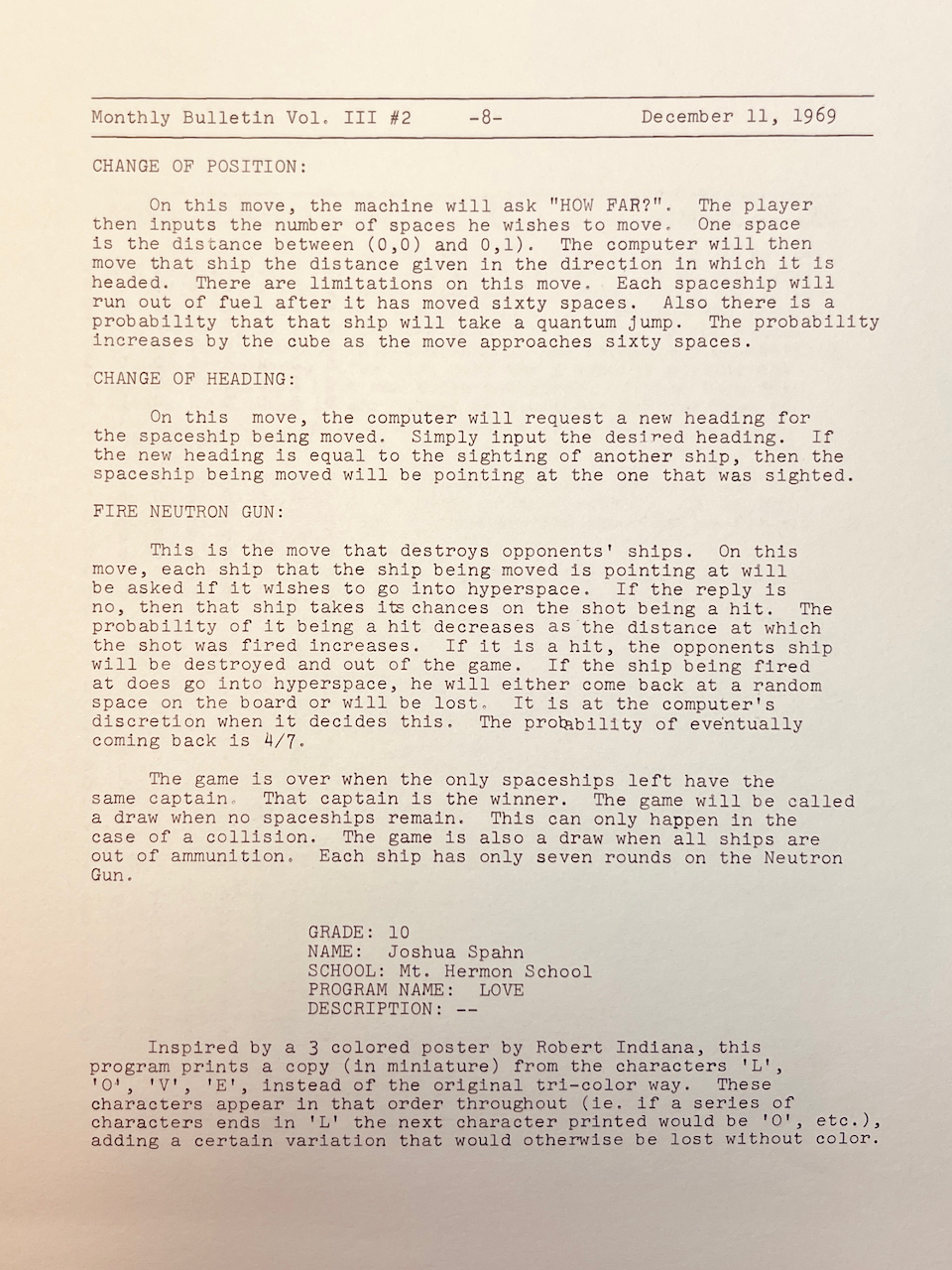

The history of LOVE
LOVE's published date of 1969 in the monthly bulletin predates the program's microcomputer versions available on the CPMUG vol 3 disk, in Ahl's 1978 Creative Computing book, or Ahl's earlier 1975 version for DEC's BASIC-PLUS published in Creative Computing. While the idea and basic structure of the LOVE program survived, its attribution to Spahn did not. It leaves me curious as to why. Most likely the code itself did not include Spahn's name. As the program was run and shared throughout the time-share BASIC community, there was no way of knowing its author, aside from the network's monthly bulletin. We can imagine that the program would be stored centrally for a time on the DTSS machines, and that users would have likely made copies for later use by sending the listing to a paper punch -- a simple task on teletype machines.
But what would justify Ahl claiming authorship of LOVE in his book? ("The love program was created by David Ahl" is stated above the listing.) Moreover, BASIC Computer Games clearly exerts a copyright on all of the content, but at least acknowledges the original program authors in other cases. My sense is that authors like Ahl spent time and effort writing new versions of programs that appeared other BASIC dialects -- not always a straightforward job -- and would have been using code that was (presumably) in the public domain. Copyrighting (or copylefting) code wasn't an established practice at the time, but a published book distributing the code could be copyrighted. We can also suppose that Ahl was inspired when he saw the output of Spahn's program, but wrote a new version from scratch.
These are among the wonderful layers of ownership, attribution, cultural remixing, and repurposing in the story of LOVE. After all, Indiana's design was co-opted by a young high school fan. In a sense, Spahn's LOVE program produces a digital sample of an iconic visual work. It's lack of attribution (or eventual mis-attribution) calls attention to the enormous changes in the concepts and attitudes of authorship and open sharing that digital works have gone through since 1969, but LOVE's story also highlights the deep roots of creative coding. The history of LOVE is a surprising journey to the early days of community-based computing, creative coding, time-sharing, and the BASIC programming language.
Notes and references
- Do people still encounter it? Perhaps it is more appropriate to say "as many people encountered it in the 1970s and 80s," especially a generation raised on microcomputers and ROM-based BASIC interpreters.
- Ahl, David H., Basic Computer Games Microcomputer Edition. Workman Publishing: New York, 1978.
- 101 Basic Computer Games. Digital Electronics Corporation: Maynard, Massachusetts, 1973.
- Kurtz, Thomas E., BASIC, in History of Programming Languages, Richard L. Wexelblat, ed. Association for Computing Machinery: New York, 1981.
- Rankin, Joy Lisi, A People's History of Computing in the United States. Harvard University Press: Cambridge, Massachusetts, 2018.
- It's interesting to note that BASIC was never intended by its inventors to be an interpreted language [4], while most popular microcomputer implementations were interpreted.
- Nevison, John, M. The Computer as Pupil: The Dartmouth Secondary School Project, Final Report, October 1970.
LOVE program listings
DEC BASIC-PLUS, 1975
10 REMARKABLE PROGRAM BY DAVE AHL 20 PRINT "A TRIBUTE TO THE GREAT AMERICAN ARTIST, ROBERT INDIANA. 30 PRINT "HIS GREATEST WORK WILL BE REPRODUCED WITH A MESSAGE OF 40 PRINT "YOUR CHOICE UP TO 60 CHARACTERS, IF YOU CAN'T THINK OF 50 PRINT "A MESSAGE, SIMPLY TYPE THE WORD 'LOVE'" \ PRINT 60 INPUT "YOUR MESSAGE PLEASE"A$ \ L=LEN(A$) 65 INPUT "OUTPUT OEVICE (LP: OR KB:)";B$ 66 IF B$="LP:" OR B$="KB:" THEN 67 ELSE PRINT "AGAIN" \ GOTO 65 67 OPEN B$ FOR OUTPUT A$ FILE 1 70 DIM T$(120) \ PRINT #1 FOR I=1 TO 10 100 FOR J=0 TO INT(60/L) 110 FOR I=1 TO L 120 T$(J*L+I))=MID(A$,I,1) 130 NEXT I \ NEXT J 140 C=0 200 A1=1 \ P=1 \ C=C+1 \ IF C=37 THEN 999 205 PRINT #1 210 READ A \ A=A1+A \ IF P=1 THEN 300 240 PRINT #1," "; FOR I=1 TO A \ P=1 \ GOTO 400 300 PRINT #1,T$(I); FOR I=A1-A TO A1-1 \ P=0 400 IF Al>60 THEN 200 ELSE 210 600 DATA 60,1,12,26,9,12,3,8,24,17,8,4,6,23,21,6,4,6,22,12,5,6,5 610 DATA 4,6,21,11,8,6,4,4,6,21,10,10,5,4,4,6,21,9,11,5,4 620 DATA 4,6,21,8,11,6,4,4,6,21,7,11,7,4,4,6,21,6,11,8,4 630 DATA 4,6,19,1,1,5,11,9,4,4,6,19,1,1,5,10,10,4,4,6,18,2,1,6,8,11,4 640 DATA 4,6,17,3,1,7,5,13,4,4,6,15,5,2,23,5,1,29,5,17,8 650 DATA 1,29,9,9,12,1,13,5,40,1,1,13,5,40,1,4,6,13,3,10,6,12,5,1 660 DATA 5,6,11,3,11,6,14,3,1,5,6,11,3,11,6,15,2,1 670 DATA 6,6,9,3,12,6,16,1,1,6,6,9,3,12,6,7,1,10 680 DATA 7,6,7,3,13,6,6,2,10,7,6,7,3,13,14,10,8,6,5,3,14,6,6,2,10 690 DATA 8,6,5,3,14,6,7,1,10,9,6,3,3,15,6,16,1,1 700 DATA 9,6,3,3,15,6,15,2,1,10,6,1,3,16,6,14,3,1,10,10,16,6,12,5,1 710 DATA 11,8,13,27,1,11,8,13,27,1,60 999 PRINT #1 FOR I=1 TO 10 \ CLOSE 1 \ END
LOVE in the Jan/Feb 1975 issue of Creative Computing
CPMUG vol. 3, 1978
120 T$="LOVELOVELOVELOVELOVELOVELOVELOVELOVELOVE" 121 T$=T$+"LOVELOVELOVELOVELOVELOVELOVELOVELOVELOVE" 122 T$=T$+"LOVELOVELOVELOVELOVELOVELOVELOVELOVELOVE" 128 REM 130 GOSUB 800 135 PRINT:PRINT:PRINT 140 C=0 200 A1=1:P=1:C=C+1 202 IF C=37 THEN 999 205 PRINT 210 READ A:A1=A1+A 212 IF P=1 THEN 300 230 FOR I = 1 TO A:PRINT " ";:NEXT I 240 P=1:GOTO 400 300 FOR I=A1-A TO A1-1:PRINT MID$(T$,I,1);:NEXT I 310 P=0 400 IF A1>60 THEN 200 410 GOTO 210 600 DATA 60,1,12,26,9,12,3,8,24,17,8,4,6,23,21,6,4,6,22,12,5,6,5 610 DATA 4,6,21,11,8,6,4,4,6,21,10,10,5,4,4,6,21,9,11,5,4 620 DATA 4,6,21,8,11,6,4,4,6,21,7,11,7,4,4,6,21,6,11,8,4 630 DATA 4,6,19,1,1,5,11,9,4,4,6,19,1,1,5,10,10,4,4,6,18,2,1,6,8,11,4 640 DATA 4,6,17,3,1,7,5,13,4,4,6,15,5,2,23,5,1,29,5,17,8 650 DATA 1,29,9,9,12,1,13,5,40,1,1,13,5,40,1,4,6,13,3,10,6,12,5,1 660 DATA 5,6,11,3,11,6,14,3,1,5,6,11,3,11,6,15,2,1 670 DATA 6,6,9,3,12,6,16,1,1,6,6,9,3,12,6,7,1,10 680 DATA 7,6,7,3,13,6,6,2,10,7,6,7,3,13,14,10,8,6,5,3,14,6,6,2,10 690 DATA 8,6,5,3,14,6,7,1,10,9,6,3,3,15,6,16,1,1 700 DATA 9,6,3,3,15,6,15,2,1,10,6,1,3,16,6,14,3,1,10,10,16,6,12,5,1 710 DATA 11,8,13,27,1,11,8,13,27,1,60 720 GOTO 999 800 PRINT CHR$(12);CHR$(127);CHR$(127);CHR$(127);CHR$(127) 810 RETURN 999 REM 1000 END
HP TIMESHARE BASIC, unknown date
LIST LOVE 10 REMARKABLE PROGRAM BY DAVID AHL, ADAPTED AND REVISED BY ELGIN LEE 12 DIM T$[120] 20 PRINT "A TRIBUTE TO THE GREAT AMERICAN ARTIST, ROBERT INDIANA." 30 PRINT "HIS GREATEST WORK WILL BE REPRODUCED WITH A MESSAGE OF" 40 PRINT "YOUR CHOICE UP TO 60 CHARECTORS, IF YOU CAN'T THINK OF" 50 PRINT "A MESSAGE,SIMPLY TYPE THE WORD 'LOVE'" 60 PRINT "YOUR MESSAGE PLEASE" 61 DIM A$[60] 62 INPUT A$ 63 PRINT LIN(5) 65 L=LEN(A$) 90 I=1 100 FOR J=1 TO INT(60/L) 110 T$[I,I+L-1]=A$ 120 I=I+L 130 NEXT J 131 IF I>60 THEN 140 135 T$[I,60]=A$[1,60-I-1] 140 C=0 200 A1=1 201 P=1 202 C=C+1 203 IF C=37 THEN 999 210 READ A 211 A1=A1+A 212 IF P=1 THEN 300 240 FOR I=1 TO A 241 PRINT " "; 242 NEXT I 243 P=1 244 GOTO 400 300 PRINT T$[A1-A,A1-1]; 301 P=0 320 IF A1 <= 60 THEN 210 330 PRINT "" 340 GOTO 200 400 IF A1>60 THEN 200 405 GOTO 210 600 DATA 60,1,12,26,9,12,3,8,24,17,8,4,6,23,21,6,4,6,22,12,5,6,5 610 DATA 4,6,21,11,8,6,4,4,6,21,10,10,5,4,4,6,21,9,11,5,4 620 DATA 4,6,21,8,11,6,4,4,6,21,7,11,7,4,4,6,21,6,11,8,4 630 DATA 4,6,19,1,1,5,11,9,4,4,6,19,1,1,5,10,10,4,4,6,18,2,1,6,8,11,4 640 DATA 4,6,17,3,1,7,5,13,4,4,6,15,5,2,23,5,1,29,5,17,8 650 DATA 1,29,9,9,12,1,13,5,40,1,1,13,5,40,1,4,6,13,3,10,6,12,5,1 660 DATA 5,6,11,3,11,6,14,3,1,5,6,11,3,11,6,15,2,1 670 DATA 6,6,9,3,12,6,16,1,1,6,6,9,3,12,6,7,1,10 680 DATA 7,6,7,3,13,6,6,2,10,7,6,7,3,13,14,10,8,6,5,3,14,6,6,2,10 690 DATA 8,6,5,3,14,6,7,1,10,9,6,3,3,15,6,16,1,1 700 DATA 9,6,3,3,15,6,15,2,1,10,6,1,3,16,6,14,3,1,10,10,16,6,12,5,1 710 DATA 11,8,13,27,1,11,8,13,27,1,60 999 PRINT LIN(5) 1000 END
Some additional questions
- Does an archival copy of Spahn's program exist?
- Is it possible to reconstruct Spahn's earlier version of LOVE using a construction grammar approach?
Hello, world
The first published BASIC program was:
10 LET X = (7+8)/3 20 PRINT X 30 END
Kemeny, J. G. and Kurtz, T. E., BASIC instruction manual. Dartmouth College: Hanover, New Hampshire, 1964.

